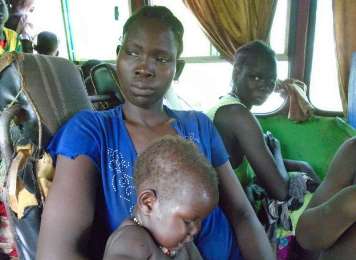UNHCR relocates 50,000 South Sudanese refugees in Ethiopia
By Tesfa-Alem Tekle
March 17, 2015 (ADDIS ABABA) – The UN refugee agency (UNHCR) on Tuesday said it has begun relocating more than 50,000 flood-affected South Sudanese refugees in Ethiopia.

A total of 51,316 refugees from flood-prone areas in two camps will be relocated ahead of the approaching rainy season.
The newly opened camp, Jewi was established to receive thousands of flood affected refugees from Leitchuor camp.
In August last year, Leitchuor and Nip Nip refugee camps were severely hit by flood after heavy seasonal rains caused the Baro River to burst its banks affecting over 50,000 South Sudanese refugees mainly women and children.
The two camps were established last year after more South Sudanese continue arriving to Ethiopia as fighting between government and rebels continues.
The UNHCR said the search for a suitable area in the Gambella region to set up more camps has become a huge challenge with a number of identified sites declared unsuitable.
Gambella, a region bordering South Sudan, is home to tens of thousands of South Sudanese who fled to Ethiopia to escape conflict at home.
The new camp has capacity to accommodate larger group of refugees and will start receiving refugees beginning the first week of next month.
During the inaugural ceremony of the new camp, UNHCR country representative Valentin Tapsoba commended Ethiopia’s open door policy towards refugees.
Tapsoba said the allocation of appropriate site for the development of the Jewi camp is “a clear evidence of the commitment of the Government of Ethiopia to ensure an effective protection of refugees”.
The new camp was inaugurated during the weekend in the presence of Ethiopia government officials, diplomats, representatives from UN and other international partners.
“Though I represent the Government of the United States of America, it is really the people of Ethiopia who are the number one donor by sharing your land, water resources and your communities with refugees” said deputy assistant secretary Catherine Wiesner of the Bureau of Population, Refugees and Migration (PRM) in Washington.
“This camp in Jewi is the latest demonstration of your generosity,” added Wiesner.
Refugees said the opening of the new camp which is built in much safer place was a big relief.
“I’m extremely excited to be relocating to a camp where we won’t fear that come the rainy season, our houses would be flooded again,” said 26-year-old Nyawour, a mother of two.
UNHCR is undertaking the relocation exercise in collaboration with the Government of Ethiopia represented by the Administration for Refugee and Returnee Affairs (ARRA) and other organisations. The International Organisation for Migration (IOM) is transporting the refugees.
“Our plan and desire is to relocate all willing refugees in a safe and dignified manner from the flood prone camps,” said Angele Djohossou, UNHCR head of sub-office in Gambella.
“UNHCR and partners are working on phased gradual exit strategy from both camps,” said Djohossou.
According to Djohossou, the strategy includes the development of peaceful coexistence projects targeting both possible residual refugee population who will not opt for relocation and the host community.
Ethiopia currently hosts about 670,000 refugees mainly from Somalia, South Sudan, Sudan and Eritrea.
The above stated figure includes over 250,000 South Sudanese in the Gambella region, of whom more than 194,000 of them fled to Ethiopia after violence erupted in the young nation in December 2013.
Ethiopia is currently Africa’s largest refugee-hosting country over taking neighbouring Kenya
(ST)
